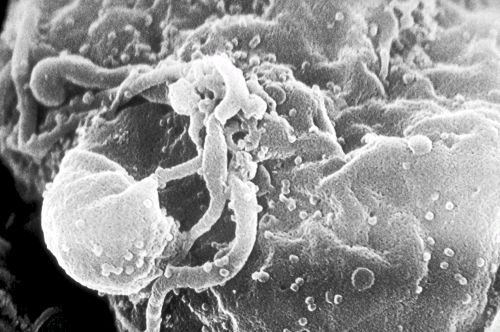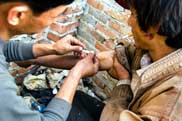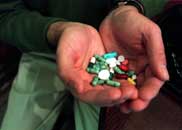 CDC/C. GOLDSMITH
CDC/C. GOLDSMITH
Article
For 25 years, governments, scientists and medical experts have desperately sought a cure for AIDS, yet none has been discovered. Why?
Learn the why behind the headlines.
Subscribe to the Real Truth for FREE news and analysis.
Subscribe NowIn 1981, researchers diagnosed a mysterious virus that was killing homosexual men in the Western United States. They named it “Gay Related Immune Deficiency” (GRID). Due to extensive lobbying efforts by homosexual and other liberal special-interest groups, the name was later changed to Acquired Immune Deficiency Syndrome—AIDS.
AIDS was initially thought of as a homosexual disease. This perception has changed, as the virus has killed millions of heterosexual men and women, with millions more presently living with it. For example, over 17 million women are currently living with the infection.
More than a generation has passed since the AIDS virus was first diagnosed. In that time millions of lives have been ruined, numerous communities destroyed and whole nations shattered. Billions of dollars have been spent to find a cure, but none has been forthcoming. To this day, there is no vaccine or cure for AIDS. Why?
Never before has there been a disease like this. Consider its scope: Since its discovery, AIDS has infected more than 65 million people worldwide. Of those infected, it has killed 25 million.
A Worldwide Pandemic
The sheer scope of the disease is mind-boggling. Presently, 40 million people worldwide are living with it—larger than the population of Canada. About 4 million were infected in 2005 alone. Sadly, many of those infected are unaware of their status.
 UNAIDS
UNAIDSIndeed, the impact of AIDS is so great that the United Nations considers it to be one of the greatest development and security issues facing the world today. In 2005, 3 million people died (averaging 8,500 per day), and within the next two years a staggering 6 million more are expected to succumb to the disease. No part of the globe has been spared its wrath, not even traditional, socially conservative societies.
Here is a snapshot of the worldwide impact of AIDS:
• North America: Over 1 million people in the United States are living with HIV (Human immunodeficiency virus, a retrovirus that causes AIDS), with 40,000 new infections occurring every year, many of them in adults under the age of 25. The primary sources of new infections are homosexual and heterosexual sex, and needle sharing by drug abusers. Recently, a new wave of infection has been attributed to the use of methamphetamine, also known as “crystal meth.”
Of particular concern to authorities is an increase in unprotected sex and “risky behavior” among young people who have grown tired of the “safe sex” message.
It is estimated that about one-fourth of those with HIV have not been diagnosed and are unaware of their infection.
• Western Europe: In this region, 570,000 to 890,000 adults currently live with HIV. AIDS-related deaths have been relatively low since the 1990s due to the availability of antiretroviral therapy. However, in some countries it is estimated that a large proportion of HIV infections remain undiagnosed, and there is worrying evidence of antiretroviral drug resistance among some newly infected individuals in this region.
 MCT
MCT• Eastern Europe and Central Asia: Evidence indicates a rapidly growing epidemic in Eastern Europe and Central Asia. An estimated 1.5 million lived with HIV in 2005. The increasing rate of infections (from the mid-1990s onward) has been due to social and economic collapse, along with increased levels of intravenous drug use.
According to the World Health Organization (WHO), by 2005 the number of reported cases in Russia was 257,000—up from 15,000 in 1995, with predictions that the infection rate will continue to rise quickly. Transmission of HIV is increasing through sexual contact and drug abuse among young adults. More than 80% of current infections in this region occur in people under the age of 30.
• Middle East and North Africa: The number of cases in these regions is relatively low, with approximately 440,000 people infected. Methods of infection are diverse, including sex between men, prostitution and intravenous drug use.
 MCT
MCT• East Asia: Though the prevalence rate is low, many are living with HIV, due to large populations in the region. The picture here is dominated by China, estimated to have up to 1.5 million cases, with some estimates even higher.
In rural areas, the number of those infected is in the tens of thousands, primarily due to large numbers of farmers participating in unclean blood transfusions.
• Latin America: HIV-infected men in Latin America outnumber HIV-infected women by roughly 3 to 1. Lower prevalence in some countries disguises serious localized epidemics.
In Mexico, Brazil, Colombia and Argentina, homosexual activity and drug use are the primary means of transmission. Brazil accounts for more than a third of all HIV infections in Latin America.
• Oceania: There are approximately 78,000 adults living with AIDS in Australia, New Zealand and other countries and territories. The number of AIDS-related deaths has been relatively low, as treatment has been widespread in this region.
• South and South-East Asia: This region has the second highest number of people with HIV infections, 7.4 million (representing 15% of all cases). Over two-thirds of AIDS infections in this region occur in India, which has now overtaken South Africa as the country with the highest number of infections in the world (5.7 million).
• Caribbean: The Caribbean has the second highest infection rate in the world. Among young adults, AIDS is the leading cause of death. The adult prevalence rate is approximately 1.6%. HIV transmission occurs mainly through promiscuous heterosexual sex, with two-thirds of AIDS cases attributed to this.
 MCT
MCT• Africa: Sub-Saharan Africa is by far the most affected region on earth. Though home to only 10% of the world’s population, more than 64% of all HIV-positive people live there. This amounts to a staggering 24.5 million (3 million of whom are children under age 15).
In 2005, there were 12 million AIDS orphans living in sub-Saharan Africa. In the 35 African nations with the highest prevalence, the average life expectancy from birth is 48 years—7 years less than it would be without the disease.
Southern Africa is the hardest hit area, with prevalence rates exceeding 20% in most countries in the region, and even 30% in Swaziland and Botswana. South Africa has the highest number of infections in Africa—5.5 million, representing 12% of the population.
AIDS has cut off economic growth in many nations, particularly in the Third World, by destroying large numbers of human lives. For example, the UN has estimated there could be as many as 90 million cases of infection in sub-Saharan Africa by 2025.
Mass infections mean that not only are many people unable to work and contribute to their economies, but also a significant financial outlay is required for medical care.
By killing off the young population, AIDS can seriously weaken the taxable population of a community. This has particularly been the case in some African countries. The UN has documented a correlation between decreasing life expectancies and the lowering of gross national product in many African countries with prevalence rates of 10% or more.
As the spread of the disease accelerates around the world, it is expected that other countries will replicate Africa’s sad experience.
The Search for a Cure
In the first decade of the epidemic, various forms of alternative medicine were used to try to treat symptoms or to alter the course of the disease itself. Treatments included massage, herbal and flower remedies, and acupuncture. None of them was found to be effective.
 MCT
MCT UNAIDS
UNAIDS UNAIDS
UNAIDSIn recent years, a series of drugs have been developed that can prolong the lives of those who are HIV positive. These antiretroviral drugs block the virus’s ability to replicate. They can delay the onset of AIDS by slowing the loss of the patients’ CD+ cells. However, they do not cure the disease, nor do they alleviate the symptoms. For many, these drugs have achieved less than optimal results. This is primarily due to non-adherence and non-persistence with antiretroviral therapy because of the complexity of the treatment programs, including the number of pills, dosing frequency and meal restrictions.
Also to be noted is that a wide variety of unpleasant side effects are associated with antiretroviral therapy: diarrhea, nausea, fatigue, vomiting, rashes, insomnia, stomach pain, headaches, etc. Damage to the liver and nerves, changes in body shape, inflammation of the pancreas, anemia and muscle pain can also result from some of the drugs. And sadly some people are becoming infected with strains of the virus that are resistant to these drugs.
Research to develop better treatments include decreasing side effects of current drugs, further simplifying drug regimens to improve adherence and determining the best sequence of regimens to manage drug resistance.
While antiretroviral drugs have proved useful in prolonging lives, it is postulated that only a vaccine would be able to cure the epidemic. However, after over 20 years of research, no effective vaccine is on the horizon.
Global Response
The past few years have brought greater international attention to AIDS. This has led to several initiatives, including The United Nations General Assembly Special Session on HIV/AIDS and Declaration of Commitment; The Global Fund to Fight AIDS, Tuberculosis and Malaria; The World Health Organization’s “3 by 5 Initiative”; and the U.S. “President’s Emergency Plan for AIDS Relief.”
Despite all the impressive sounding initiatives, governments and organizations around the world have struggled to cope with the AIDS pandemic. Large sums of money have been thrown at the problem, with little to show for it. UNAIDS estimates that HIV/AIDS spending rose from $300 million in 1996 to $8.3 billion in 2005. However, with more money to go around, disagreements are emerging as to how it should be spent. The Bush administration has committed an impressive $15 billion to fight AIDS, but the White House has come under criticism by some for giving priority to projects that promote sexual abstinence over condom use.
In addition to trying to find a cure, another approach that has been promoted is “prevention,” i.e. reducing the number of people who actually contract the virus. One method of prevention is the “CNN Approach,” which promotes condom use for those who engage in risky sexual behavior; using clean needles; negotiating safer sex with a partner; and encouraging women to make wise choices. This has been the most popular approach worldwide.
On the other hand, the United States endorses the “ABC Approach.” This involves abstinence or delay of sexual activity, especially for youths; being faithful to one’s sexual partner; and condom use for those engaging in risky sexual behavior. This approach has been effective in Uganda, where HIV prevalence has decreased from 15% to 5%.
Challenges Ahead
The main challenge in combating AIDS is in providing patients with access to treatment. According to the UNAIDS/WHO “3 by 5” progress report, only 20% of those in need of treatment are now receiving it. Indeed, only one in eight people who want to be tested are currently able to do so. It should be noted that while the cost of a year’s antiretroviral treatment has fallen sharply, over 80% of the people who most need these medicines still do not have access to them. It will be difficult to address this situation, as there will need to be investment to build hospitals and train staff.
Finding a safe, effective vaccine is proving to be difficult, and it is unlikely there will be any effective immunizations before the end of the decade. There are around 30 different AIDS vaccines currently undergoing trials.
And then there are the financial challenges. The $8.9 billion available for AIDS funding in 2006 is far short of the $14.9 billion the UN estimates is needed to effectively counteract the spread of the disease. A similar shortfall in funding is expected in 2007. In addition, the International AIDS Vaccine Initiative points out that only 1% of global research and development is being channeled into finding an AIDS vaccine.
The Cause and the Cure
To understand how to cure AIDS, one must first understand what is causing it. Simply put, for every cause there is an effect. Numerous research studies have concluded that AIDS is spread primarily in two ways—sexual contact and intravenous drug use. On the sexual front, it has mainly spread by what has been termed “risky behavior,” including homosexual sex, sexual intercourse with more than one partner and paid sex. Therefore, AIDS is different than most diseases; it is spread through certain types of behavior. It is a “lifestyle disease.”
Nations have been unable to solve the AIDS pandemic because they have tried to eradicate the disease without first addressing the cause. AIDS has accelerated as the world plummets to greater depths of immorality. Sexual behaviors once considered “unacceptable,” “horrible,” “shameful” and “unspeakable” just two or three generations ago are now accepted as “alternative lifestyles” and as “lifestyle choices.” What was once considered to be evil is now acceptable (Isa. 5:20). As a result, the world is reaping a grim penalty in deadly, incurable diseases (Rom. 1:26-28).
Yet AIDS is a preventable disease—IF people did not participate in illicit drug use and promiscuous sexual relations outside of marriage, conduct God never intended for mankind. Yet the overwhelming majority will not accept this—and will become indignant at even the suggestion of changing one’s lifestyle! Most would rather treat the effect and not deal with the true cause.
Yet there are innocent victims who have not engaged in the wild lifestyle and have still contracted the disease through the actions of others, causing them to needlessly suffer. For example, some contract HIV or AIDS through blood transfusions, adulterous spouses, infected parents and superstitious practices.
The toll of AIDS continues to mount. As long as every man does “what is right in his own eyes” (Judges 21:25), even greater suffering and death is yet to come.


